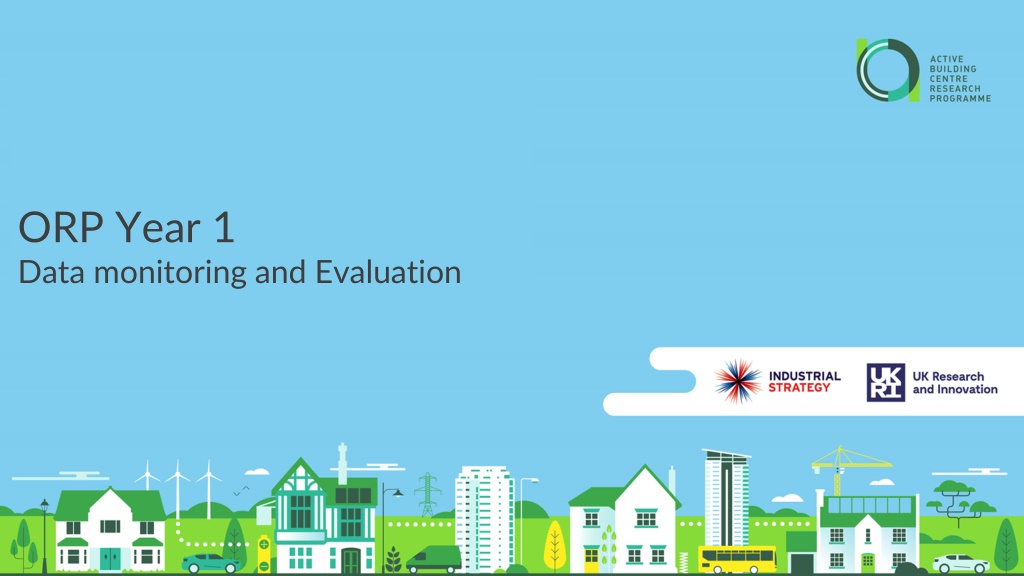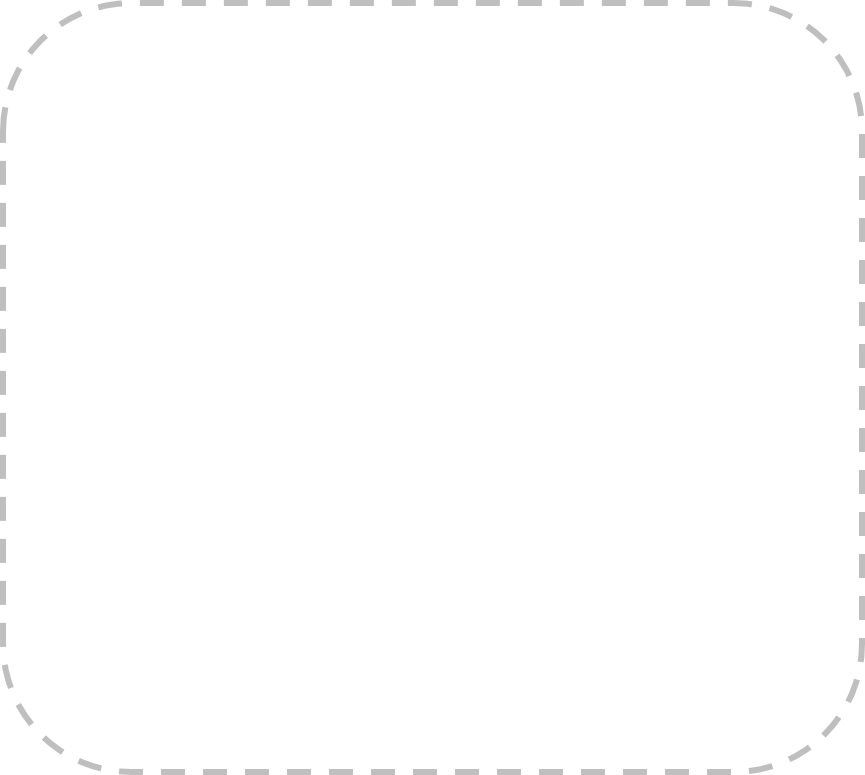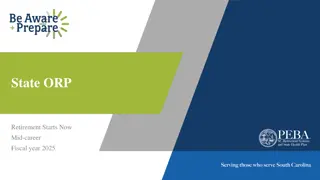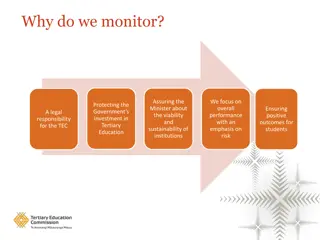ORP Year 1 Data Monitoring and Evaluation Overview
Collecting performance data from energy retrofit schemes across Wales to develop a robust evidence base. Evaluation includes metering, fabric efficiency, heating system performance, renewables generation, and environmental monitoring without user knowledge. Performance evaluation of Vale of Glamorgan and Isle of Anglesey hybrid heating schemes integrating heat pump and gas boiler systems for space heating.
Download Presentation

Please find below an Image/Link to download the presentation.
The content on the website is provided AS IS for your information and personal use only. It may not be sold, licensed, or shared on other websites without obtaining consent from the author. Download presentation by click this link. If you encounter any issues during the download, it is possible that the publisher has removed the file from their server.
E N D
Presentation Transcript
ORP Year 1 Data monitoring and Evaluation
ORP Data Monitoring and Evaluation Collecting in-use performance data from schemes across ORP. ~1500+ homes in ORP 1 Schemes from across Wales, covering a wide variety of energy and carbon focussed retrofit interventions: Fabric efficiency Electrification of heat Energy generation and storage Hybrid systems Dynamic control Variable tariffs To develop a much needed retrofit evidence base
Data collection for evaluation Metering of main energy meters and relevant building systems Fabric performance Heating System Performance Heating and Hot Water Demand Renewables generation Storage and Control Internal & External Environmental monitoring Overall energy, costs and carbon Received and analysed without knowledge of use of homes Aggregated performance in the real-world Outline Building Information
ORP Year 1 - Performance Evaluation Vale of Glamorgan & Isle of Anglesey Hybrid Heating Schemes
Vale of Glamorgan Hybrid Heating 5kW Heat pump systems integrated with existing gas boiler systems. Providing space heating when optimal. Controlled by PassivSystems Installed in over 100 homes, across Vale of Glamorgan and Isle of Anglesey. Building Types Building Age
Vale of Glamorgan Hybrid Heating Gas Boiler Space Heating Hot Water
Vale of Glamorgan Hybrid Heating Electricity Gas Heat Pump 5kW Boiler Space Heating Hot Water
Vale of Glamorgan Hybrid Heating Electricity Gas Heat Pump 5kW Boiler Space Heating Hot Water
Vale of Glamorgan Hybrid Heating Electricity Gas Heat Pump 5kW Boiler Space Heating Hot Water Consistent data from 18 homes, across a consistent time period. Oct 2021 Mar 2022
Hybrid System Heat Delivery October to March Heat Delivery - Winter HP kWh Boiler kWh 9000 8000 7000 Heat Delivery / kWh 6000 5000 4000 3000 2000 1000 0 204126 204131 204132 204545 205164 205170 205171 205172 205173 205250 205389 205402 205407 205430 205434 205437 206664 207134 Anonymised building ref
Hybrid System Heat Delivery October to March % Contribution Percentage Contribution Anonymised building ref
Hybrid System Heat Delivery October to March % Contribution Oct - Mar Boiler / HeatPump Delivery Ratio 120.00% Average Heat Pump 81% Boiler 19% 100.00% Percentage Contribution 80.00% Max Heat Pump 99+% Boiler 1% 60.00% Boiler Contribution HP Contribution 40.00% Min Heat Pump 32% Boiler 68% 20.00% 0.00% Anonymised building ref
Hybrid System Heat Delivery 12 month Extrapolated Heat Delivery per annum HP kWh Boiler kWh 12000 Heat Delivery kWh / annum 10000 8000 6000 4000 2000 0 204126 204131 204132 204545 205164 205170 205171 205172 205173 205250 205389 205402 205407 205430 205434 205437 206664 207134 Anonymised building ref
Hybrid System Heat Delivery 12 month Extrapolated Heat Delivery per annum 12000 High* (4-5 person) Heat Delivery kWh / annum HP kWh 10000 Boiler kWh Med* (2-3 person) 8000 6000 Low* (1 person) 4000 2000 *OFGEM Typical Domestic Consumption Values 0 204126 204131 204132 204545 205164 205170 205171 205172 205173 205250 205389 205402 205407 205430 205434 205437 206664 207134 Anonymised building ref
Hybrid System Heat Delivery 12 month Extrapolated Heat Delivery per m2 200 Boiler kWh/m2 Heat Delivery kWh/m2 per annum HP kWh/m2 180 160 140 120 100 80 60 40 20 0 204126 204131 204132 204545 205164 205170 205171 205172 205173 205250 205389 205402 205407 205430 205434 205437 206664 207134 Anonymised building ref
Hybrid System Heat Delivery 12 month Extrapolated Heat Delivery per m2 200 Boiler kWh/m2 Heat Delivery kWh/m2 per annum HP kWh/m2 180 160 140 120 Average UK Building Stock 100 80 Building Regs Part L typical (56 kWh/m2.annum) 60 40 20 PassivHaus target (15 kWh/m2.annum) 0 204126 204131 204132 204545 205164 205170 205171 205172 205173 205250 205389 205402 205407 205430 205434 205437 206664 207134 Anonymised building ref
Heat Loads Summary Observed heat demand from homes aligns with typical UK building stock, and aligns with age of dwellings monitored. Heat pumps have been able to meet over 80% of heating load.
Heat Pump Efficiency Average COP over testing period Heat Pump - COP (Energy Efficiency) 3.5 Average SCOP 2.8 3 2.5 Average COP Max SCOP 3.2 2 1.5 Min SCOP 1.8 1 0.5 0 204126 204131 204132 204545 205164 205170 205171 205172 205173 205250 205389 205402 205407 205430 205434 205437 206664 207134
Heat Pump Efficiency By Month 3.5 3 2.5 While Heat Pump COP s are typically higher in summer as heat pumps have to do less work to generate heat, the higher COP s in Winter seen here are down to long run periods. Average COP 2 1.5 1 0.5 0 Jan Feb Mar Jun Jul Aug Sep Oct Nov Dec
Heat Pump Usage By Month 1000 900 800 700 While low COP s were seen during summer months (previous slide) kWh / Month 600 500 Heat pumps were barely used during this period. 400 300 200 100 0 Jan Feb Mar Jun Jul Aug Sep Oct Nov Dec
Cost and Carbon Analysis Analysis based on average performance values: Heat pump to Boiler use ratio: 81% / 29% Average COP of Heat Pump: 2.8 Assumed average boiler efficiency: 82%
Cost and Carbon Analysis 2021 Apr 2022 (Cost Cap) 7.44p 102 28.29p 168 4.01p 96.49 20.46p 87.21 Gas cost p/kWh Gas standing charge /annum Electricity cost p/kWh Electricity standing charge /annum Average Gas Carbon Intensity Average Electricity Carbon Intensity 0.184 kgCO2/kWh 0.233 kgCO2/kWh (2020*) *Last published annual figures
Heating Cost Comparison 2021 Costs Cost Comparison 450 390 400 48 350 267 300 / Year 250 200 342 150 267 363 100 50 0 Hybrid Boiler Only Elec Gas Hybrid Boiler Only
Heating Cost Comparison 2021 Costs 46% higher 390 48 267 / Year 342 267 363 Hybrid Boiler Only
Heating Cost Comparison 2022 Prices Cost Comparison 700 616 595 600 500 390 / Year 400 267 300 200 100 0 Hybrid Boiler Only Hybrid (2022) Boiler Only (2022) Elec Gas 2021 costs 2022 costs
Heating Cost Comparison 2022 Prices Hybrid 46% higher Hybrid 3.5% higher 616 595 390 / Year 267 2021 costs 2022 costs
Heating Cost Comparison 2022 Prices Cost Comparison Hybrid 46% higher Hybrid 3.5% higher 700 616 595 600 500 390 / Year 400 267 300 200 100 0 Hybrid Boiler Only Hybrid (2022) Boiler Only (2022) Elec Gas 2021 2022 Elec / Gas = 5x Elec / Gas = 3.8x
Carbon Comparison 1,600.00 1363kge 1,400.00 1,200.00 1,000.00 kgCO2eper annum 800.00 654kge 600.00 400.00 200.00 0.00 Hybrid Boiler Only Hybrid Boiler Only
Carbon Comparison 1,600.00 1363kge 1,400.00 1,200.00 1,000.00 kgCO2per annum 800.00 654kge 600.00 400.00 200.00 0.00 Hybrid Boiler Only 52% Reduction
Key Findings Heat pumps achieved their performance potential on homes without other interventions. High levels of space heating contribution with corresponding carbon emissions reductions (52%) Cost impact, based on 2021 tariff caps was significant (46%), though this has reduced significantly based on 2022 cap gas/electricity ratio. Good controls important to ensure heat pumps operate effectively.
Key Findings Costs may be reduced further through additional interventions: Reducing space heating demand through fabric measures. Use of thermal storage and variable energy tariffs (when sensible) Heating systems replaced to facilitate lower circulation temperatures. (Radiators and potentially pipework)
Carmarthenshire Data and Evaluation
Retrofit Scope 7no. Semi Detached Homes 1945-1964 Existing Condition Retrofit Scope Cavity wall insulated Loft insulation Uninsulated floors 6no. Gas boilers 1no. Oil boiler EPC C-D External Wall Insulation Additional loft insulation Underfloor insulation Triple glazing PV (2-4kW) Battery (10kWh) 1no. ASHP / 2no. New gas boiler MVHR s
Data collection for evaluation Fabric performance: SmartHTC, overall demand, kWh/m2 Heating System Performance: New ASHP and Gas Boiler performance Impact of boiler replacement. Internal environment Renewables generation: PV generation Storage and Control: Battery utilisation. Self consumption of renewables. Export. Leveraging cheap energy tariffs. Offsetting cost impact of ASHP. Overall Carbon and Cost
































